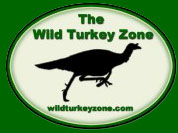|
Physical Characteristics
The wild turkey has longer
legs and neck, a more slender body, smaller head,
and darker plumage than does the domestic turkey.
Tips of wild turkey tail feathers are light brown,
while those of the domestic turkey are white.
 Male
wild turkeys (gobblers) differ from females (hens)
by having longer legs and neck, a larger foot, and
larger bodies. Males have a bronzy, iridescent body
plumage with black-tipped breast feathers, and hens
have light-brown breast feather tips. The gobbler
typically has a tuft of modified feathers called a
"beard" protruding from its breast, along
with an upwardly curving spur on the lower legs (see
photo at right). Occasionally the beard or spurs do
not develop on a gobbler. A few hens will also develop
beards although they are typically much thinner and
shorter than gobbler beards. Male
wild turkeys (gobblers) differ from females (hens)
by having longer legs and neck, a larger foot, and
larger bodies. Males have a bronzy, iridescent body
plumage with black-tipped breast feathers, and hens
have light-brown breast feather tips. The gobbler
typically has a tuft of modified feathers called a
"beard" protruding from its breast, along
with an upwardly curving spur on the lower legs (see
photo at right). Occasionally the beard or spurs do
not develop on a gobbler. A few hens will also develop
beards although they are typically much thinner and
shorter than gobbler beards.
The head and neck of
the adult gobbler are typically whiter than a hen's,
due to less head feathering. During the spring mating
season, the head of the sexually aroused adult gobbler
takes on a combination of red, white, and blue colors
in varying degrees.
Several color phases
of the wild turkey are recognized. The red phase occurs
mainly in southern Mississippi and can be described
as a rusty, reddish color on the tail, wings, or most
body feathers. The smoky-gray phase occurs throughout
Mississippi and is mistakenly thought to be a partial
domestic turkey. Smokey-gray turkeys, usually hens,
are whitish grayish in color on parts or most of the
body. They are not part domestic and do successfully
reproduce. Another color phase seen infrequently is
the black (melanistic) phase. These turkeys have no
other colors, just black. The true albino, with a
total absence of any color, is rare.
The sex of a wild turkey
or a flock can be determined by sign. Gobblers have
a large track with a middle toe at least 4 inches
in length; a hen has a middle toe less than 3 inches
long. Hen droppings are spiral shaped, but gobblers
typically leave an elongated J-shaped dropping. In
the spring, juvenile turkeys can be distinguished
from adults by an uneven tail contour, an unbarred
(white bars) tip on the tenth primary wing feather,
and short, greater upper-secondary coverts. Jakes,
or yearling gobblers, normally weigh 9 to 13 pounds
and have short, rounded spurs and a beard less than
5 inches long. Older toms generally weigh between
16 and 21 pounds and have spurs longer than half an
inch and a beard more than 7 inches long. First-year
hens (jenny) typically weigh 5 to 7 pounds; adult
hens average 9 pounds.
|

